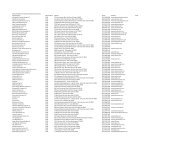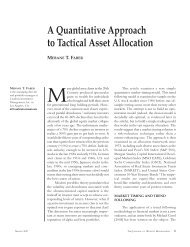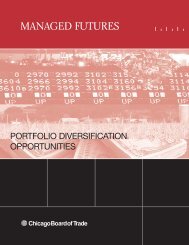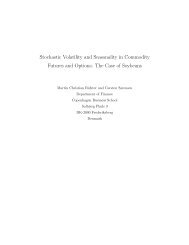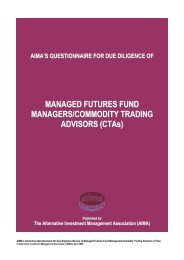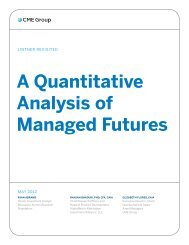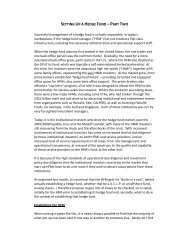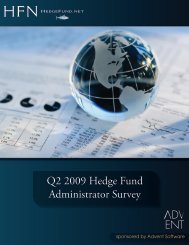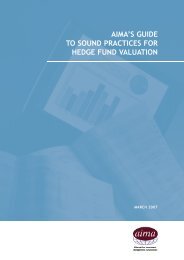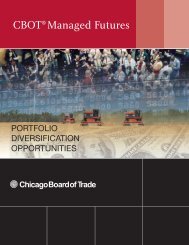Definitions & Concepts... [PDF] - Cycles Research Institute
Definitions & Concepts... [PDF] - Cycles Research Institute
Definitions & Concepts... [PDF] - Cycles Research Institute
Create successful ePaper yourself
Turn your PDF publications into a flip-book with our unique Google optimized e-Paper software.
<strong>Cycles</strong> <strong>Research</strong> <strong>Institute</strong><br />
http://www.cyclesresearchinstitute.org/<br />
<strong>Definitions</strong> and <strong>Concepts</strong> Used in Cycle Study<br />
by Edward R. Dewey<br />
This article originally appeared in the<br />
Foundation for the Study of <strong>Cycles</strong><br />
Magazine <strong>Cycles</strong> in May 1965
<strong>Definitions</strong> and <strong>Concepts</strong> Used in Cycle Study<br />
by E. R. Dewey<br />
I have often been asked to provide authoritative. definitions for words used in cycle study. Only if all of us<br />
who are engaged in this work use words to mean the same thing can we understand each other clearly. This<br />
article is a first attempt to satisfy this demand.<br />
First, let us turn to the dictionary to get some preliminary meanings for some of the more common words.<br />
ORDER. L. ordo, order. Conformity to law.<br />
PATTERN. OF. patron, from L. pater, father. An arrangement or composition that suggests or reveals a<br />
design; a configuration; formal or regular arrangement.<br />
CYCLE. Gr. kyklos, ring, circle, cycle. A complete course of operation returning to the original state.<br />
FLUCTUATION. L. fluctuate, to wave, Fr. fluctum, to flow. Wavelike motion. Fluctuate suggests irregular<br />
or alternating movements, especially up and down.<br />
OSCILLATION. L. oscillare, to swing. The act of fluctuating within or between relatively fixed limits. (In<br />
physics, a single swing from one extreme to the other of an oscillating body.)<br />
WAVE. A. S. wafian, to wave. One of a series of undulations. Something that swells and has a crest, or<br />
rises and falls, like a wave.<br />
RECURRENCE. L. from re currere, to run. The act of occurring again, especially after an interval.<br />
RHYTHM. Gr, rhythmos, measured motion. Movement marked by reasonably regular recurrence, or<br />
reasonable regularity of alternation.<br />
PERIODICITY. Gr. periodos, a going around. A perfectly regular idealized motion.<br />
Dictionary meanings are good for a starter but they are not precise enough for scientific purposes.<br />
Moreover, there are many concepts for which there are no single words -male Manx cats, (or white) for<br />
example! If you are to get an adequate idea of the various sorts of cycles it is preferable to start with the<br />
concepts and try to find words-where they exist-that will more or less correspond. This is better than<br />
starting with the words and trying to pick meaning for them; or, like Humpty Dumpty (and some others)<br />
making up meanings of your own!<br />
("When I use a word," Humpty Dumpty said, as you will remember, “'it means just what I choose it to mean<br />
- neither more nor less.'”)<br />
“Cycle” - to use a catch-all or omnibus word - is a subdivision of the basic concept of “order”, but to see<br />
how we get from the one to the other it will be helpful to refer to the diagram on the next page. The various<br />
boxes contain words describing concepts. The boxes are under each other in ever-increasing order of<br />
limitation of meaning. To the right of the boxes I have placed the contrasting concept. To the left of the<br />
boxes I have placed the popular word - where there is one - that more or less expresses the concept<br />
described within the box.<br />
In the topmost box I have placed the word order. Order, of course, is fundamental. Order is the antithesis of<br />
chaos. Order is law. For me, order comes closer than any other single word to the meaning of the universe.<br />
(If you will permit me to use all of four words, I would express the meaning of the universe as “fulfillment<br />
of the law.”)
Pattern is the broadest of the words we use in cycle study. It is any arrangement that suggests or reveals<br />
design or order. It is the antithesis of unpattern - for example, the surface of a mirror, or sheets of polished<br />
steel, as they appear to the naked eye. Pattern is one of the eight or ten prime constituents of the universe. It<br />
is as fundamental as time, space, energy, matter, life, change, motion, emotion, thought, consciousness.<br />
(If you were God, sitting down to create the universe, as we know it, what other basic building blocks would<br />
you first need to create? What else is there in the universe?)<br />
Examples of pattern are infinite. They run from a straight line to an oriental rug, from a circle to an ocean<br />
liner. Pattern can be one, two or three dimensional. It can represent, either in one, two, or three dimension,<br />
the passage of time. Time is not a necessary condition of pattern. You can have pattern in space - for<br />
example, a colonade; or a maple leaf; or the capital of a Corinthian column. However, the only kind of<br />
pattern with which we are concerned in cycle study is pattern in time (or its two-dimensional representation<br />
on a chart).<br />
Unfortunately I can think of no single word to express the concept of pattern in time in contrast to the<br />
concept of pattern in space (design).<br />
Pattern in time can be cyclic or non-cyclic. Cyclic, as you know, means a complete course of operation<br />
returning to the original state. It is a series of changes regarded as leading back to its starting point. It<br />
involves sequence in contrast to separate (discrete) events. Many examples of cyclic pattern in time could<br />
be given. A business cycle, for instance, or a four-cycle engine, or a seasonal weather cycle (summer, fall,<br />
winter, spring, and summer again), or the life cycle of an insect (egg, larva, pupa, adult, and egg again). In<br />
all instances, what we have is a succession of events from a starting point through a variety of changes back,<br />
more or less, to the starting point.<br />
Non-cyclic patterns in time are time patterns that do not return to the place of beginning - populations<br />
growth is a good example, or the daily weight of a growing baby. Both of these sequences are definitely<br />
patterns in time, but because they do not return to the original state they are not cyclic. The popular word<br />
that most nearly describes cyclic patterns in time, as the phrase is being used here, is fluctuation.<br />
(This is not to say that the words “cycle” or “cyclic” do not have other perfectly valid meanings. Most<br />
words have other meanings. For example, my dictionary gives 23 different meanings for the word “order”!)<br />
Cyclic pattern in time can be repetitive or nonrepetitive - many cycles, or just one cycle. Business exhibits<br />
repetitive cyclic patterns in time. Starting, let us say, with a depression, business rises and falls and comes<br />
around to another depression, time after time. Also, one can speak of a single business cycle: the sequence<br />
from one depression to the next. The best popular word for repetitive cyclic pattern might be fluctuations<br />
(plural). A nonrepetitive cycle could perhaps best be called a wave, but the words cycle, fluctuation,<br />
oscillation, undulation are also used.<br />
Note that we have not yet introduced the idea of regularity of time. Two consecutive business depressions<br />
could be 3 years or 20 years apart. We are talking merely of repetition.<br />
At this point a new concept must be introduced-the concept of recurring events. Recurring events are similar<br />
to recurring cycles in that they are both recurring in time, both (at this point in our outline) may be any<br />
interval apart. The point of difference is that the recurring cycle is a sequence, a coming around again,<br />
whereas the recurrent events are discrete. Art forms that repeat again and again over the ages are good<br />
examples of recurrent events. So are certain religious symbols. So are volcanic eruptions or earthquakes. So<br />
are the deaths of presidents in office. (In any given year, or month, week, or day, the president dies or he<br />
doesn't.) All these examples are “yes” or “no” matters.<br />
Do not overlook the importance of recurrent events. First, they require different statistical treatment than do<br />
repetitive cycles. Second, sequences that we observe as repetitive cycles may sometimes be triggered by<br />
recurrent events.<br />
From now on these two concepts occupy parallel positions on our diagram.
Repetitive cyclic patterns and recurrent events (which, by definition, must also be repetitive) can be ordered<br />
or random. In cycle and pattern study we are of course interested in the ordered patterns and in separating<br />
the ordered from the nonordered. The fact that the behavior is ordered has two aspects to it. These need to<br />
be clearly distinguished. Almost any cyclic behavior is ordered in that the consecutive states are related, one<br />
to the other. It has what the statisticians call “serial correlation”. Stock prices tomorrow are related to stock<br />
prices today. They may be a little higher or a little lower, but never drastically up or down. They do not go<br />
from 900 to 200 in one day and back to 600 the day after as they would do if they were completely random.<br />
When we talk about ordered cycles we are not talking about this kind of randomness, but rather about the<br />
randomness or lack of it of the period or length of the cycle (or, in the case of recurrent events, of the<br />
intervals between the events). We ask, are these spacings ordered or random?<br />
The word oscillation, which implies a little more regularity than the word fluctuation, could perhaps be used<br />
for ordered, repetitive, cyclic pattern in time, but it is not entirely satisfactory. M. G. Kendall uses the word<br />
oscillation to denote fluctuations that are “subject to law, and therefore predictable”. The trouble here is that<br />
you can have ordered repetitive cyclic patterns in time that are not predictable, at least in any practical sense<br />
of the word. And of course the word oscillation does not apply to recurrent events at all.<br />
Ordered repetitive cyclic patterns in time can be rhythmic or nonrhythmic (and ordered recurrent events can<br />
be, too). A complication here is that rhythm, or reasonably regular repetition, can be found in random<br />
repetitive cyclic patterns and in random recurrent events, too. This fact is indicated by the run-around lines<br />
on the diagram.<br />
Rhythm means that the length of the successive waves -or the intervals between successive recurring events<br />
- are “reasonably” regular, so that the behavior repeats with a beat. Your heart beats are rhythmic. Old<br />
Faithful geyser is rhythmic (or at least it was until the earthquake).<br />
Rhythm, of course, is a relative, not an absolute, concept. One time series is more rhythmic than another.<br />
Therefore, although you can say that “nonrhythmic” is the contrasting concept, it is not really a question of<br />
black or white but of progressive shades of grey. “Reasonable” regularity is, of course, a subjective<br />
measure, but it can be made mathematically exact such as “80% on the regularity index scale”.<br />
The importance of rhythm is that rhythm involves regularity (of timing), and where you have regularity<br />
(regularity not the result of chance) you have predictability. Predictability is what w e are all after.<br />
When rhythmic cyclic patterns or rhythmic recurrent events evidence complete regularity they are called<br />
periodic and the pattern is called a periodicity. It is, of course, much harder, by mere chance, to get true<br />
periodicity than to get mere rhythm, but, even so, it can be done. Toss a coin, for example. Nothing could<br />
be more random. Yet you might easily get a head, a tail, a head, a tail, a true periodicity if there ever was<br />
one. You might even get three repetitions: a head, a tail, a head, a tail, a head, a tail. And yet it would mean<br />
nothing!<br />
On the other hand, if your cycle were longer, a true periodicity would be much harder to get. Suppose you<br />
had five heads followed by five tails, you would hardly expect the pattern to repeat even once.<br />
And now for a recapitulation:<br />
1. Order includes pattern and everything else in the universe except chaos.<br />
2. Pattern includes pattern in time and all other sorts of pattern, but does not include other basic concepts.<br />
3. Pattern in time includes cyclic pattern in time and non-cyclic pattern in time, but excludes pattern in<br />
space.<br />
4. Cyclic pattern in time includes repetitive cyclic patterns in time and non-repetitive or single cyclic<br />
patterns in time, but excludes non-cyclic pattern in time.
(There is no corresponding “recurrent” event, because, unless repetitive, there is no recurrence. You could,<br />
of course, put “event” as a concept, but from our point of view here the pattern consists of the intervals<br />
between the events, and there are no intervals until you have at least two occurrences.)<br />
5. Repetitive cyclic patterns in time (or in recurrent events) can be ordered or random, rhythmic or nonrhythmic,<br />
but do not include one single cyclic sequence (wave) or one single event.<br />
6. Ordered repetitive cyclic patterns in time (or ordered recurrent events) can be rhythmic or not.<br />
7. Rhythmic cyclic patterns in time or rhythmic repetitive events, both of which, by definition, must be<br />
repetitive, (but which may be either ordered or random), may or may not be truly periodic.<br />
8. Truly periodic cyclic patterns in time and truly periodic recurrent events-are both patterns developed to<br />
the nth degree and are therefore necessarily special cases of recurrent cyclic patterns in time or recurrent<br />
events.<br />
I trust that these distinctions will prove helpful.


![Definitions & Concepts... [PDF] - Cycles Research Institute](https://img.yumpu.com/26387731/1/500x640/definitions-amp-concepts-pdf-cycles-research-institute.jpg)
